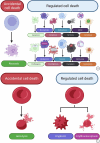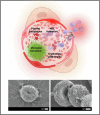Current understanding of eryptosis: mechanisms, physiological functions, role in disease, pharmacological applications, and nomenclature recommendations
- PMID: 40592821
- PMCID: PMC12216432
- DOI: 10.1038/s41419-025-07784-w
Current understanding of eryptosis: mechanisms, physiological functions, role in disease, pharmacological applications, and nomenclature recommendations
Abstract
Early studies have shown that erythrocytes have caspase-3 and caspase-8 and are capable of dying through an apoptotic-like cell death triggered by Ca2+ ionophores. This cell death is associated with apoptosis-like morphological signs, including cell shrinkage, membrane blebbing, and phosphatidylserine externalization. To emphasize that mature erythrocytes don't have the apoptotic mitochondrial machinery and distinguish this unique cell death modality from apoptosis, it was named "eryptosis". Over recent decades, our knowledge of eryptosis has been significantly expanded, providing more insights into the uniqueness of cell death pathways in erythrocytes. In this review, we aim to summarize our current understanding of eryptosis, formulate the nomenclature and guidelines to interpret results of eryptosis studies, provide a synopsis of morphological and biochemical features of eryptosis, and highlight the role of eryptosis in health and disease, including its druggability.
© 2025. The Author(s).
Conflict of interest statement
Competing interests: The authors declare no competing interests.
Figures






Similar articles
-
The uremic solute 3-carboxy-4-methyl-5-propyl-2-furanpropionate (CMPF) may enhance eryptosis and increase erythrocyte osmotic fragility through potential activation of PIEZO1.Nephrol Dial Transplant. 2025 Jun 30;40(7):1342-1349. doi: 10.1093/ndt/gfae275. Nephrol Dial Transplant. 2025. PMID: 39568068 Free PMC article.
-
Polo-like kinase inhibitor BI2536 induces eryptosis.Wien Med Wochenschr. 2023 Apr;173(5-6):152-157. doi: 10.1007/s10354-022-00966-7. Epub 2022 Sep 30. Wien Med Wochenschr. 2023. PMID: 36178637 English.
-
Red Cell Death in Renal Disease: The Role of Eryptosis in CKD and Dialysis Patients.Cells. 2025 Jun 24;14(13):967. doi: 10.3390/cells14130967. Cells. 2025. PMID: 40643488 Free PMC article. Review.
-
The use of Open Dialogue in Trauma Informed Care services for mental health consumers and their family networks: A scoping review.J Psychiatr Ment Health Nurs. 2024 Aug;31(4):681-698. doi: 10.1111/jpm.13023. Epub 2024 Jan 17. J Psychiatr Ment Health Nurs. 2024. PMID: 38230967
-
Systemic pharmacological treatments for chronic plaque psoriasis: a network meta-analysis.Cochrane Database Syst Rev. 2017 Dec 22;12(12):CD011535. doi: 10.1002/14651858.CD011535.pub2. Cochrane Database Syst Rev. 2017. Update in: Cochrane Database Syst Rev. 2020 Jan 9;1:CD011535. doi: 10.1002/14651858.CD011535.pub3. PMID: 29271481 Free PMC article. Updated.
References
Publication types
MeSH terms
Substances
Grants and funding
LinkOut - more resources
Full Text Sources
Research Materials
Miscellaneous

